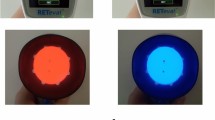Abstract
Background
Subjective scoring of pupil reactivity is a fundamental element of the neurological examination for which the pupillometer provides an objective measure.
Methods
This single-blinded observational study examined interrater reliability of pupil exam findings between two practitioners and between practitioners and a pupillometer.
Results
From 2329 paired assessments, the interrater reliability between practitioners was only moderate for pupil size (k = 0.54), shape (k = 0.62), and reactivity (k = 0.40). Only 33.3 % of pupils scored as non-reactive by practitioners were scored as non-reactive by pupillometry.
Conclusions
Despite the strong emphasis placed on the traditional pupil examination, especially for patients with a neurological illness, there is limited interrater reliability for subjective scoring of pupillary assessments. Thus, the use of automated pupillometers should be examined as a potential method to increase the reliability of measuring of pupil reactivity.

Similar content being viewed by others
References
Greenberg MS, Arredondo N. Handbook of neurosurgery. 6th ed. Lakeland: Greenberg Graphics, Thieme Medical Publishers; 2006.
AANN. AANN Core curriculum for neuroscience nursing. 5th ed. Glenview: American Association of Neurosciene Nurses; 2010.
Campbell WW. DeJong’s The Neurologic examination. 7th ed. Philadelphia: Lippincott Williams & Wilkins; 2005.
Plum F, Posner JB. The diagnosis of stupor and coma. Ed. 3. ed. Philadelphia: Davis; 1980.
Blumenfeld H. Neuroanatomy through clinical cases. Sunderland: Sinauer; 2002.
Marmarou A, Lu J, Butcher I, et al. Prognostic value of the Glasgow Coma Scale and pupil reactivity in traumatic brain injury assessed pre-hospital and on enrollment: an IMPACT analysis. J Neurotrauma. 2007;24(2):270–80.
Narayan RK, Greenberg RP, Miller JD, et al. Improved confidence of outcome prediction in severe head injury. A comparative analysis of the clinical examination, multimodality evoked potentials, CT scanning, and intracranial pressure. J Neurosurg. 1981;54(6):751–62.
Chesnut RM, Gautille T, Blunt BA, Klauber MR, Marshall LE. The localizing value of asymmetry in pupillary size in severe head injury: relation to lesion type and location. Neurosurgery. 1994;34(5):840–5 (discussion 845–846).
Majdan M, Steyerberg EW, Nieboer D, Mauritz W, Rusnak M, Lingsma HF. Glasgow coma scale motor score and pupillary reaction to predict six-month mortality in patients with traumatic brain injury: comparison of field and admission assessment. J Neurotrauma. 2015;32(2):101–8.
Braakman R, Gelpke GJ, Habbema JD, Maas AI, Minderhoud JM. Systematic selection of prognostic features in patients with severe head injury. Neurosurgery. 1980;6(4):362–70.
Ritter AM, Muizelaar JP, Barnes T, et al. Brain stem blood flow, pupillary response, and outcome in patients with severe head injuries. Neurosurgery. 1999;44(5):941–8.
Tien HC, Cunha JR, Wu SN, et al. Do trauma patients with a Glasgow Coma Scale score of 3 and bilateral fixed and dilated pupils have any chance of survival? J Trauma. 2006;60(2):274–8.
Manley GT, Larson MD. Infrared pupillometry during uncal herniation. J Neurosurg Anesthesiol. 2002;14(3):223–8.
Goebert HW Jr. Head injury associated with a dilated pupil. Surg Clin North Am. 1970;50(2):427–32.
Clusmann H, Schaller C, Schramm J. Fixed and dilated pupils after trauma, stroke, and previous intracranial surgery: management and outcome. J Neurol Neurosurg Psychiatry. 2001;71(2):175–81.
Andrews BT, Pitts LH. Functional recovery after traumatic transtentorial herniation. Neurosurgery. 1991;29(2):227–31.
Sakas DE, Bullock MR, Teasdale GM. One-year outcome following craniotomy for traumatic hematoma in patients with fixed dilated pupils. J Neurosurg. 1995;82(6):961–5.
Schallenberg M, Bangre V, Steuhl KP, Kremmer S, Selbach JM. Comparison of the Colvard, Procyon, and Neuroptics pupillometers for measuring pupil diameter under low ambient illumination. J Refract Surg. 2010;26(2):134–43.
Zafar SF, Suarez JI. Automated pupillometer for monitoring the critically ill patient: a critical appraisal. J Crit Care. 2014;29(4):599–603.
Meeker M, Du R, Bacchetti P, et al. Pupil examination: validity and clinical utility of an automated pupillometer. J Neurosci Nurs. 2005;37(1):34–40.
Fountas KN, Kapsalaki EZ, Machinis TG, Boev AN, Robinson JS, Troup EC. Clinical implications of quantitative infrared pupillometry in neurosurgical patients. Neurocrit Care. 2006;5(1):55–60.
Munoz Negrete FJ, Rebolleda G. Automated evaluation of the pupil. Arch Soc Esp Oftalmol. 2013;88(4):125–6.
Kramer CL, Rabinstein AA, Wijdicks EF, Hocker SE. Neurologist versus machine: is the pupillometer better than the naked eye in detecting pupillary reactivity. Neurocrit Care. 2014;21(2):309–11.
Witting MD, Goyal D. Interrater reliability in pupillary measurement. Ann Emerg Med. 2003;41(6):832–7.
Wilson SF, Amling JK, Floyd SD, McNair ND. Determining interrater reliability of nurses’ assessments of pupillary size and reaction. J Neurosci Nurs. 1988;20(3):189–92.
Landis JR, Koch GG. The measurement of observer agreement for categorical data. Biometrics. 1977;33(1):159–74.
Gwet KL. Inter-rater reliability using SAS : a practical guide for nominal, ordinal, and interval data. Gaithersburg: Advanced Analytics, LLC; 2010.
Viera AJ, Garrett JM. Understanding interobserver agreement: the kappa statistic. Fam Med. 2005;37(5):360–3.
Chen Y, Kardon RH. Studying the effect of iris mechanics on the pupillary light reflex using brimonidine-induced anisocoria. Invest Ophthalmol Vis Sci. 2013;54(4):2951–8.
McHugh ML. Interrater reliability: the kappa statistic. Biochem Med (Zagreb). 2012;22(3):276–82.
Chen JW, Gombart ZJ, Rogers S, Gardiner SK, Cecil S, Bullock RM. Pupillary reactivity as an early indicator of increased intracranial pressure: the introduction of the Neurological Pupil index. Surg Neurol Int. 2011;2:82.
Song Z, Zheng W, Zhu H, et al. Prediction of coma and anisocoria based on computerized tomography findings in patients with supratentorial intracerebral hemorrhage. Clin Neurol Neurosurg. 2012;114(6):634–8.
Du R, Meeker M, Bacchetti P, Larson MD, Holland MC, Manley GT. Evaluation of the portable infrared pupillometer. Neurosurgery. 2005;57(1):198–203 (discussion 198–203).
Author information
Authors and Affiliations
Corresponding author
Ethics declarations
Conflict of Interest
The authors declare that they have no conflict of interest.
Funding
The study received no direct funding. Pupillometers were loaned to the university by Neuroptics Inc., at no cost for the duration of the study.
Additional information
On behalf of The University of Texas Southwestern Medical Center, Neurology & Neurotherapeutics.
Rights and permissions
About this article
Cite this article
Olson, D.M., Stutzman, S., Saju, C. et al. Interrater Reliability of Pupillary Assessments. Neurocrit Care 24, 251–257 (2016). https://doi.org/10.1007/s12028-015-0182-1
Published:
Issue Date:
DOI: https://doi.org/10.1007/s12028-015-0182-1




